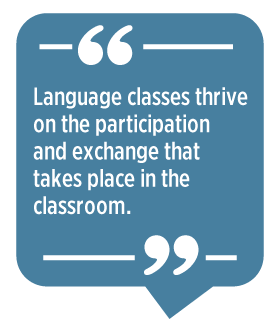Alternatives for Language Practice and Assessment in Online Classes
by Khanh-Duc Kuttig

COVID-19 has changed the way we all teach, and traditional
face-to-face teaching has been forced to move online. Though some courses can
be easily adapted for online delivery and self-study, other courses, especially
those for language practice, need to be redesigned or tweaked so that
participants can still receive the interaction and practice that they would
normally get in the classroom.
Language
classes thrive on the participation and exchange that takes place in the
classroom. Interaction creates learning opportunities; that interaction in
itself is learning (Allwright, 1984). How can we provide our learners with the
opportunities afforded by classroom interaction in an online environment? This
article suggests some guidelines to bear in mind when planning an online course
and introduces some practical activities that have worked well in a language
skills course taught completely online. Though the course was for preservice
teachers, these activities can be easily adapted for any other online language
course.
General
Considerations
You don’t
need a lot of technology or knowledge about technology to run an online course
well. What you do need, though, is to have a clear idea of what you and your
students want to achieve, and can achieve with the tools that you have. Before
designing your online course, determine what tools you have, and what you know
how to use. Use only tools that you can use well—struggling with technology in
the middle of a course can get frustrating for both learners and teacher alike.
You want your course to run smoothly from the get-go.
Here is a
list of guidelines to help you begin:
-
Decisions on learning design
will take priority over decisions on technology. Use the technology to achieve
your learning objectives, and not for the sake of the technology itself.
-
Keep your online course
simple. Use a basic set of tools to avoid the frustrations that can arise from
trying out something unfamiliar.
-
Do
not make assumptions about your learners. We often work from our perspective
and when something goes wrong, we tend to blame our learners. The pandemic has
shown us how big the digital divide is. From not having the tools to not
knowing how to use the tools, we should always find out what our learners can
and are able to do before implementing tools which we presume are beneficial.
-
Provide choices and
backups. Let your learners choose the technology or task that they are
comfortable with so as to avoid frustration, which in turn leads to
demotivation.
-
Have students work in study
groups. Being in study groups takes away the loneliness of distance learning.
When your students work in study groups, you can assign group activities that
encourage more communication among students.
-
Be
there. Moving a course online doesn’t mean that you can take a back seat and
let the course run on its own. Your job isn’t to simply upload material and
assign tasks. You need to engage with your learners and show them that you are
on this learning journey with them. Do this by commenting on their
contributions, producing 10- to 15-minute mini-lectures and recording your
instructions instead of using lengthy PowerPoint lectures. Where students are
required to complete a new task, provide an example so that they have an idea
of what is expected.
-
Review your course at the
end. If you run the same course often, look back at the course, the materials,
and learning activities and reflect on what worked well and what didn’t. Use
feedback from your students.
To get started, first
decide on what tools to use and how these can benefit your learners in the
online environment. Once you’ve made these decisions, you can begin to plan
your input and activities.
Audio and Video
Recordings
Recordings
made by students can be a good substitute for oral work in an online course.
Students can record themselves either individually or in their study groups.
Both audio and video recordings work well and can be easily implemented into a
course. When introduced and explained well, students usually have a lot of fun
making their recordings. Here are some ideas.
 Practicing
Pronunciation
Practicing
Pronunciation
If you want
them to practice a particular feature of pronunciation, such as intonation in
questions, you could get them make recordings of themselves and submit these.
While such an activity may seem inauthentic, completing the activity actually
does provide students with much more targeted practice in achieving accuracy in
spoken language. Students normally do not submit the first recording that they
have made. They will listen to themselves and try to produce the target
language as best they can, and they will only submit the recording once they
are happy with their work. Often, this involves a process of recording,
listening, and rerecording. There is greater concentration and effort involved
here. If there is a sample that students can listen to and model, all the
better.
Producing
Podcasts
Podcast
activities also work well. Getting students to produce a radio show has been a
popular project in language teaching, and podcasting can be more dynamic and
interactive than recordings of themselves, as described previously. Students
submit a series of recordings, usually ranging from 2 to 5 minutes, over the
duration of the course. You can decide whether to make these recordings
available to the rest of the class. Have them listen to each other’s
contributions and give feedback.
Some
advantages of this podcast assignment are that the topics for each episode can
be aligned to the topics in your course, and, at the end, your students will
have a digital portfolio of their work. Students can usually use the recording
tool on their phones to record their podcast episodes and then upload their
recordings either to the class cloud or the learning management system. You
could also get your students to write a transcript for their podcast episodes.
This type of
activity is ideal for both individual and group work. Topics that work well for
preservice teachers include classroom management discussions and language to
think about questions, for instance, What could you say if you wanted
your students to work in groups of three?
Videos
Another way
that mobile technology can be exploited is through videos. Be sensitive though,
as not everyone will be willing to share a video of themselves, especially if
they do not know their classmates. A good alternative would be to allow them to
use a hand puppet as a substitute for themselves. You could also have the video
assignment focus on something else, like a process or a scene instead of on the
student. All that is needed is the student’s voice. Get your students to
produce a video introduction of themselves for their first session. To help
them, you could define a set of questions they should answer, but remember not
to be too personal. The video should not be longer than 2 minutes. For
preservice teachers, you could have them produce an introduction where they
imagine they are introducing themselves to their school class for the first
time. As with the voice recordings, these can be uploaded to the cloud for the
rest of the class.
Feedback
Adopt the
three “Ps” of feedback: personal, peer, and professional. Though the
professional feedback, which comes from the instructor, is the one that
students value most, adopting personal and peer feedback encourages students to
take more responsibility for their own learning. Have them look at their own
work and assess themselves—they can listen to their own recordings or read
through their own writing. Give them a rubric or provide them with reflection
questions.

Peer
feedback, when done correctly, works really well, too. Provide a structure for
participants, so that the feedback is useful and can be built upon. A good
frame is “P-Q-P”: Praise, Question, and Polish. In praise,
students mention at least one thing they liked about the piece of work they’re
reviewing; in question, they ask about something they did
not understand; and last, in polish, the reviewer gives
one suggestion on how to make the piece better. Peer feedback given online also
encourages interaction among students.
Creative
Assessment
Portfolio
Assignments
Portfolio
assignments can be interesting and, while they require some planning, can work
well if your students have been working independently throughout the course.
There are two types of portfolios: the showcase and the assessment portfolio.
In the showcase portfolio, your students submit a digital portfolio of what
they feel is their best work throughout the course. The assessment portfolio is
more selective. It includes a selection of work, their own reflections and peer
reviews, as well as your feedback. If students have had to produce a second
piece based on the feedback, this second piece of work would be included in the
portfolio as well.
Reflection
Assignments
An
end-of-course reflection where students review what they have done in the
course and what they feel they have learnt is another idea. Some students find
this rather challenging, especially if it has been a long course with a lot of
input and output. A good alternative is the language learning log, which is
more regular and ongoing. This type of assignment helps students to
systematically document progress and encourages self-assessment. In an online
class, students can keep a digital journal and submit this at the end of the
course.
Final
Thoughts
Be kind to
your students and yourself, and always go for activities and tools that work
for both of you. When your students have more than one course online, less is
often more. When assignments are manageable and students receive regular
feedback, the learning experiences that you have designed will be much more
valuable.
Reference
Allwright,
R. L. (1984). The importance of interaction in classroom language learning. Applied Linguistics, 5(2), 156–171.
Further
Reading
Brown, J. D.
(2013). New ways of classroom assessment, revised. TESOL
Press.
Vorholt, J.
(2019). New ways in teaching speaking. TESOL
Press.
Khanh-Duc Kuttig began teaching when
there were almost no ed tech tools. She now teaches with a range of tools which
she cannot live without. She works at the University of Siegen in Germany, runs
monthly Tech Talk meetings for her teaching association, has an MA in TESOL,
and is hoping to start her MSc in educational technology this autumn. Khanh-Duc
is also the 2021 TESOL Teacher of the Year.